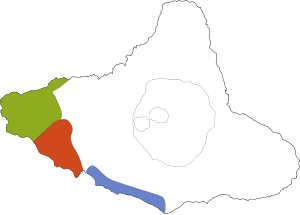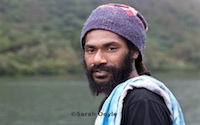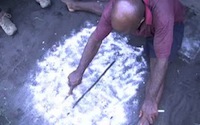
The languages of West Ambrym: Dal kalaen (green), Daakaka (orange), Daakiye (blue) © Kilu von Prince
The pacific island nation Vanuatu has the highest density of languages in the world. In the West of the island of Ambrym alone, there are three major language varieties, Daakiye, Daakaka and Dal kalaen. For each of these languages, there is some internal dialectal variation, most drastically so in the Dal kalaen region.
Several factors put the long-term survival of these languages at risk:
- They have only small populations of speakers, about one to two thousand each
- They have not had a standardized orthography so far and as good as no written documents have existed
- They are not yet used as languages of education at schools; instead, Vanuatu’s national languages, Bislama, English and French are used for instruction
- No written or spoken media such as radio or newspapers exist in the vernaculars.
The languages have some properties which are typical of Oceanic languages, such as the pronominal system, which has four numerus – singular, dual, paucal and plural – and a distinction between inclusive an exclusive for the non-singular numerus. All the following examples come from von Prince’s dissertation work on Daakaka.
| Person | Singular | Plural | Dual | Paucal |
| 1ex | nye | kinyem | kenma | kinyemsi |
| 1in | ar | ada | ansi | |
| 2 | ngok | kimim | kama | kamsi |
| 3 | nge | nyo | nya | nyosi |
Another feature which is widespread among Oceanic languages is the inflection of relational nouns: We usually don’t talk about ‘legs’ or ‘fathers’ without referring to the person the legs belong to, or the person to who someone is a father. In many languages, such nouns are therefore inflected according to person. For example in Daakaka, ‘my head’ is betuk, while ‘your head’ is batom; the shape and especially the ending of the noun already indicates who the head belongs to.
In addition, Daakaka has a third type of noun: In addition to nouns which are not inflected and can stand alone such as em ‘house’ and inflected nouns such as betuk ‘my head’, there are nouns such as neti ‘offspring-of’, which need to be followed by a second noun as in neti tyu, literally ‘offspring-of chicken’.
Other remarkable and unique properties include the modal system of the language and the range of uses of serial predicate constructions.







